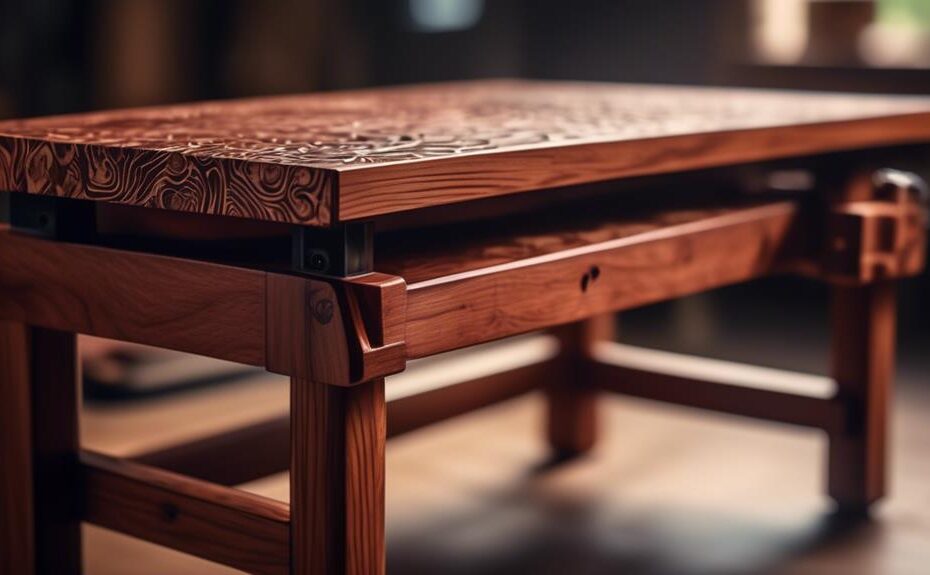When it comes to choosing the perfect wood for your workbench, there are plenty of options to consider.
Pine is a popular choice due to its affordability and accessibility.
On the other hand, maple offers durability and strength.
But what about lesser-known wood varieties?
In this discussion, we will explore the pros and cons of different types of wood for workbenches, revealing the factors that should influence your decision.
So, let's dive into the fascinating world of workbench woods and uncover the secrets they hold.
Key Takeaways
- Pine is an affordable and versatile option for workbenches, but it is prone to dents and scratches.
- Maple, especially hard maple, offers strength, durability, and resistance to wear and tear for workbenches.
- Other wood options like beech, oak, ash, birch, and walnut provide various qualities such as hardness, strength, durability, and shock resistance for workbenches.
- When choosing wood for a workbench, factors to consider include project requirements, task demands, customization, sealing and maintenance, and suitability for different woodworking needs.
Pine
Pine is a popular choice for workbenches due to its affordability, durability, and versatility.
One of the main benefits of using pine for a workbench is its affordability. Pine is widely available and relatively inexpensive compared to other hardwoods, making it an attractive option for those on a budget.
Another advantage is its durability. While not as strong as hardwoods like oak or maple, pine is still a sturdy and reliable choice for a workbench that can withstand heavy use.
Additionally, pine is a versatile wood that can be easily worked with, allowing for customization and modifications to suit individual needs.
However, it is important to note that pine is softer than hardwoods, which means it may be more prone to dents and scratches. It also has a tendency to absorb moisture, which can lead to warping or splitting if not properly sealed or maintained.
Despite these disadvantages, pine remains a popular and practical choice for workbenches.
Maple
When considering alternative options for a workbench, one wood that stands out for its strength, durability, and aesthetic appeal is maple. Maple is a popular choice among woodworking professionals due to its exceptional qualities. There are two main types of maple used for workbenches: hard maple and soft maple.
Hard maple, also known as sugar maple, is the preferred choice for workbenches due to its superior hardness and resistance to wear and tear. It is incredibly durable and can withstand heavy use, making it ideal for woodworking projects that require a sturdy surface. Soft maple, on the other hand, is more affordable and easier to work with, but it is not as hard or durable as hard maple.
Here is a table outlining the benefits of using maple for a workbench:
| Benefits of Maple for Workbenches |
|---|
| Strength and Durability |
| Resistance to Wear and Tear |
| Aesthetic Appeal |
| Availability and Affordability |
Other Wood Options

There are several wood options that can be considered as alternatives for a workbench, each with its own unique characteristics and suitability for different woodworking needs. While maple is often the top choice due to its strength and durability, other woods can also be suitable for workbenches.
One such option is beech, which is known for its hardness and resistance to wear and tear. Another option is oak, which is exceptionally strong and can withstand heavy use. Ash is another wood that is commonly used for workbenches due to its durability and shock resistance. Additionally, birch and walnut can also be considered as they are both durable materials that can provide stability and longevity to woodworking projects.
When selecting a wood for a workbench, it is important to consider the specific requirements of the project and choose a wood that can withstand the demands of the task at hand.
Frequently Asked Questions
What Are the Benefits of Using Hardwoods Like Maple for a Workbench?
Benefits of using hardwoods like maple for a workbench include durability, strength, and resistance to wear and tear. Choosing the right wood for a workbench is crucial in ensuring a long-lasting and reliable workspace for various professional tasks.
Can Softwoods Like Pine Be Suitable for Heavy-Duty Workbench Use?
The longevity of softwoods in heavy-duty workbench use is limited compared to hardwoods. When comparing the durability of softwoods and hardwoods in workbench construction, hardwoods like maple are generally preferred for their superior strength and resistance to wear and tear.
Are There Any Alternative Wood Options That Can Be Used for a Workbench Besides Pine and Maple?
Alternative wood options for workbenches offer unique advantages and drawbacks. Hardwoods like oak provide durability and strength, while birch offers affordability and stability. Consider the specific demands of your workbench to make an informed decision.
How Does the Cost of Pine Compare to Other Wood Options for a Workbench?
When comparing the durability of pine to other wood options for workbenches, it is important to consider the availability and accessibility of different wood options. The cost of pine may vary depending on the market and location.
Are There Any Specific Maintenance or Care Requirements for Workbenches Made From Different Types of Wood?
Different types of wood used for workbenches have varying maintenance requirements. Hardwoods, such as oak or maple, are durable and require minimal maintenance. However, they can be more expensive compared to softwoods like pine or fir.
Conclusion
In choosing the ideal wood for a workbench, it is crucial to consider factors such as durability, stability, and affordability.
Pine, with its practicality and affordability, is a popular choice. However, maple, known for its strength and resistance to wear, may be a better option for heavy-duty work.
Other wood options, like oak or beech, offer their own unique advantages.
Ultimately, the choice depends on the specific needs and preferences of the woodworker.




